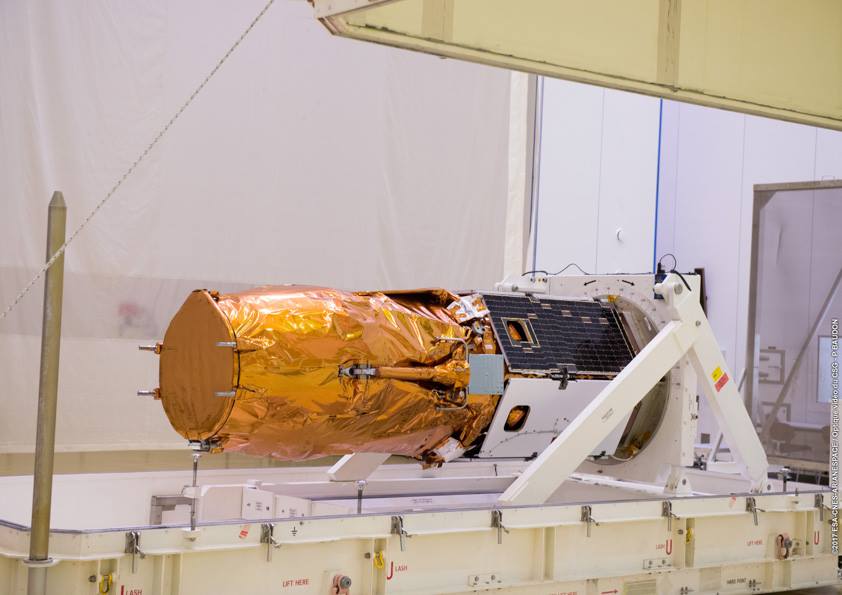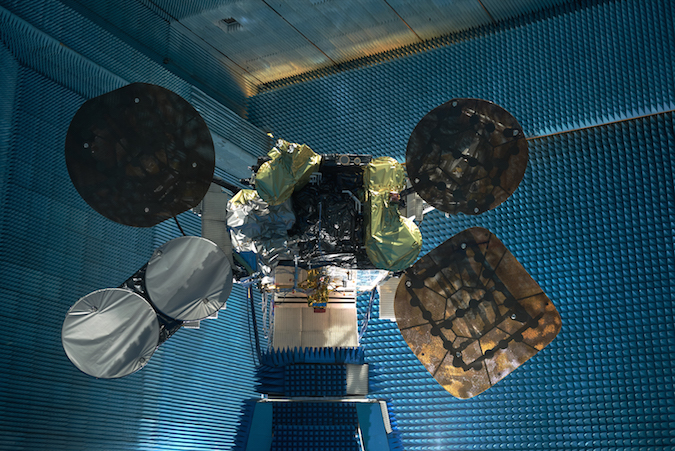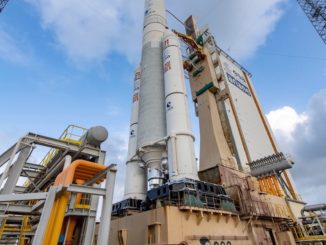
Fresh off the successful launch and initial checkout of two of its spacecraft earlier this month, Israel’s top satellite manufacturer sees a robust global market for new low-altitude reconnaissance payloads, but little international demand for its communications satellites.
Israel Aerospace Industries built two satellites that launched together Aug. 2 on a European Vega rocket from French Guiana.
One of the payloads, named Optsat 3000, will collect high-resolution surveillance imagery for the Italian military, while the other satellite, named Venµs, is part of a French-Israeli project to track the health of vegetation.
The double launch symbolized IAI’s recent growth in the field of Earth observation satellites, particularly in the construction of satellites for foreign governments. The successful Vega liftoff with Optsat 3000 and Venµs came 11 months after the the last Israeli-built communications satellite — Amos 6 — was destroyed in the explosion of a SpaceX Falcon 9 rocket during a countdown rehearsal at Cape Canaveral.
Since the loss of Amos 6, a satellite IAI sold to Israeli-owned Spacecom Ltd., the manufacturer’s communications satellite line has remained dormant.
Opher Doron, general manager of IAI’s space division, said discussions with Spacecom and the Israeli government on a new homemade communications spacecraft are still underway.
IAI wants more business from the Israeli government, Doron said, just as commercial satellite manufacturers receive from their domestic governments in the United States, Europe and Japan.
“We’ve been in significant discussions with the government on the need for governmental support in order to keep us alive, as governments do throughout the world in the telecom business,” Doron said in an interview with Spaceflight Now. “The government’s got a good understanding of that, but whether it’s got the required budget for it is under debate.”
He added that IAI is “optimistically” hoping to get started on the next Israeli communications satellite in the coming months.
“But it’s far from certain,” he added.
If IAI wins a contract, the satellite could be another commercial Amos broadcasting and data relay craft owned by Spacecom, or it could be government-owned, Doron said.
He said last year’s loss of Amos 6 on the launch pad “was a big blow in many ways.”
The fiery explosion was dramatic and jarring, even to veterans in the space industry. For IAI, it signaled the destruction of the company’s biggest-ever satellite, a design it hoped to replicate through more orders from Spacecom or international customers.
“We’re still reeling from that one,” Doron said. “It is what it is. You’re sort of braced for it during a launch, but you’re really not braced for it two days before launch. That’s life.”

Spacecom has not ordered a replacement for the lost Amos 6 satellite. The company instead arranged a four-year lease of a spacecraft from AsiaSat already in orbit, for repositioning over the European and Middle East coverage area intended for Amos 6.
Boeing won a contract from Spacecom late last year to build the Amos 17 communications satellite, the first time the Israeli telecom company purchased a spacecraft from a U.S. builder.
While questions still hover over IAI’s future in the telecom market, things look better in the Earth-imaging sector.
Doron said multiple Earth observation satellites similar in design to Optsat 3000 are in the company’s order book. But he identified only one of the Earth-imaging craft by name, the commercial Eros-C optical reconnaissance satellite set for launch in 2019 for ImageSat International, an Israeli imaging company.
Other Earth observation satellites in IAI’s backlog have been sold to other customers. When asked, Doron declined to identify their owners, or whether the satellites were for the Israeli government, foreign governments, or undisclosed commercial operators.
IAI secured the contract to build the $182 million Optsat 3000 satellite for the Italian Ministry of Defense as part of a reciprocal arrangement, in exchange for the Israeli military’s purchase of Italian-made jet trainers.
Without specifying the exact resolution of Optsat 3000’s images, Doron said it will offer “WorldView-class” image sharpness from its operating orbit 280 miles (450 kilometers) above Earth. DigitalGlobe’s latest WorldView satellites have cameras capable to resolving features as small as 31 centimeters, or 12 inches, on the ground from an even higher orbit.
But the WorldView satellites currently orbit were more expensive than IAI’s Optsat 3000, and lighter Earth-imaging spacecraft lack the resolution.
“The generic Optsats offer 50 centimeters (resolution) from 600 kilometers, although this one will be better because it’s lower, so it’s super-high resolution,” Doron said. “This satellite is also optimized to cover very large areas. It’s very agile, so it can cover lots of targets in many areas using different scanning modes and different scanning directions.”
The Eros-C imaging satellite will have similar resolution — 40 centimeters (15.7 inches) from an altitude of 500 kilometers (310 miles), according to ImageSat.
Doron told Spaceflight Now he was optimistic a successful demonstration of Optsat 3000’s capabilities would bolster IAI’s foothold in the Earth observation satellite market, a segment in which the Israeli manufacturer competes with European builders Airbus Defense and Space and Thales Alenia Space, plus U.S.-based Space Systems/Loral, a relative newcomer to small spacecraft tailored for remote sensing.
“We think we are in a fantastic position in the market,” Doron said. “We are the world leader in resolution at this weight and price. It’s a great opportunity to show that off, and having the honor to sell that to the Italian Ministry of Defense is a nice feather in our cap.”
The same basic satellite design flown on Optsat 3000 could also host high-resolution radar instruments to take pictures of Earth day and night, regardless of weather conditions. Optical cameras like the one on Optsat 3000 are blocked by clouds and darkness.
Doron declined to discuss IAI’s ongoing work to supply the Israeli government’s spy satellites.
“We’re in an upturn in the market for very high-resolution satellites,” Doron said. “We’re seeing more and more customers in several areas of the world realizing that they need very high-resolution, very high-performance satellites, hopefully at an affordable price. Some optical, some SAR (synthetic aperture radar), and several want both, and there’s a flurry of activity in that field as more and more countries realize that they need performance we can provide.”
Doron thinks IAI’s capabilities in Earth observation, already on the market for several years, are starting to get more attention.
“I think we were premature in arriving on the scene,” Doron said. “The market wasn’t there a few years ago … I think we’re very well-placed to do some interesting business several places in the world, with a very unique capability at the price point we’re offering.”
The Venµs satellite launched in tandem with Optsat 3000 showcases the adaptability of IAI’s design, according to Doron.
“Our bus is generic, but it undergoes small changes for different types of missions,” he said. “It’s a similar bus for Tecsar, for Optsat and for Venµs, but instead of a huge imaging telescope, this has got a significantly smaller super-spectral telescope. It’s got 12 colors in specifically chosen bands for environmental and vegetation monitoring according to the requirements of the scientific investigators.”
IAI is also developing a robotic lunar lander set for launch to the moon late next year, Doron said.
The lunar mission is managed by SpaceIL, an Israeli startup established to compete for the Google Lunar X Prize, a competition among international teams to send a privately-funded robotic lander to the moon. SpaceIL will miss the deadline to win the $20 million grand prize due to launch delays, but the project continues.
Other teams competing for the prize are under schedule pressure to complete their missions by the end of March 2018, and it’s unclear if any will succeed in time.
“We’re doing integration and some of the design for them, and it’s really exciting,” Doron said. “We’re already working on it and integrating and getting ready for launch at the end of ’18.”
The SpaceIL lander will ride into space piggyback as a secondary payload on a SpaceX Falcon 9 rocket, then use its own thrusters to steer toward the moon.
“I think Israel’s got a pretty good chance of being country No. 4 to land on the moon, and that’s a pretty big and exciting honor,” Doron said.
Email the author.
Follow Stephen Clark on Twitter: @StephenClark1.



